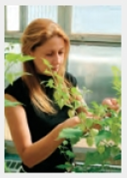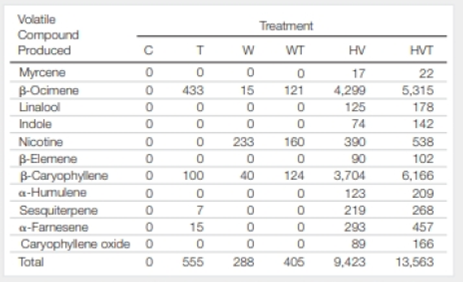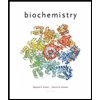

Volatile Secondary Metabolites in Plant Stress Responses In 2007, researchers Casey Delphia, Mark Mescher, and Consuelo De Moraes (pictured at left) published a study on the production of different volatile chemicals by tobacco plants in response to predation by two types of insects: western flower thrips and tobacco budworms. Their results are shown in FIGURE 30.19.

FIGURE 30.19 Volatile (airborne) compounds produced by tobacco plants in response to predation by different insects. Plants were untreated (C), attacked thrips (T), mechanically wounded (W), mechanically wounded and attacked by thrips (WT), attacked by budworms (HIV), or attacked by budworms and thrips (HVT). Values are in nanograms/day.
Which treatment elicited the greatest production of volatiles?
To find: The treatment that elicited the greatest production of volatiles in tobacco.
Concept introduction: One of the most striking features of plants is that they are capable of producing sugars by using the sun light; this phenomenon is called as photosynthesis. Thus, the sugars that are produced are primary metabolites. In addition to this, the plants also produce secondary metabolites. Secondary metabolites are mainly involved in the plant interactions with the environment where they live and help to adjust the behavior and growth of the plant. Volatile compounds produced by the plants are mainly the secondary metabolites. They are the compounds that provide smell and taste to the plants.
Explanation of Solution
Plants attacked by budworms and thrips (HVT) or budworms alone (HV) produced a total of 11 different volatiles in the amounts of 13,563 ng/day and 9,423 ng/day, respectively. The greatest production of volatile compounds produced in tobacco plant is mainly due to the treatment of HVT. It has produced 13,556 ng/day, which indicates that the treatment has a very large impact on the secondary metabolite production in tobacco.
Plants that are attacked by budworms and thrips (HVT) have produced the maximum volatile compounds in the amount of 13,563 ng/day. There are 11 compounds produced by tobacco by this treatment.
Want to see more full solutions like this?
Chapter 30 Solutions
Biology: The Unity and Diversity of Life (MindTap Course List)
Additional Science Textbook Solutions
Laboratory Manual For Human Anatomy & Physiology
Anatomy & Physiology: The Unity of Form and Function
Marine Biology (Botany, Zoology, Ecology and Evolution)
Human Anatomy & Physiology (2nd Edition)
Microbiology: An Introduction
Anatomy & Physiology
- If photosynthesizing plants are grown in thepresence of 14CO2, is every carbon atom of the glucose that is produced labeled with the radioactive carbon? Why or why not?arrow_forwardOn a hot, dry day, plants close their stomata to conserve water. Explain the connectionbetween the oxidation of water in photosystem II of the light-dependent reactions and thesynthesis of glyceraldehyde-3-phosphate (G3PA) in the light-independent reactions. Predict theeffect of closed stomata on the synthesis of G3PA and justify the prediction.arrow_forwardThe conversion of pyruvate into oxaloacetate is an anaplterotic reaction to replenish citrus acid cycle metabolites that were used up during animalism. True or falsearrow_forward
- distribution of Benzene in a 4-compartment PBK model after an exposure of 6h. Convert Berkeley Madonna code to Matlab. Note: The parameters in the table below are for a mouse model. 1a) What are the two type of products containing Benzene consumers were recently concerned about. Which of these two different type of products is likely more harmful? (hint: check news/reports and social media channels) 1b) Plot Jresp along with the concentrations of Benzene in blood, fat, non-fat and liver in a 24h window (pdf). Why is Jresp slightly decreasing within 6h of exposure? Here is the Berkeley Madonna code: {Top model} METHOD RK4 STARTTIME = 0 STOPTIME = 24 DT = 0.02 {Reservoirs Blood, Fat, NonFat and Liver} d/dt (NF) = + Jnf INIT NF = 0 d/dt (F) = + Jf INIT F = 0 d/dt (B) = - Jnf - Jf - Jl + Jresp INIT B = 0 d/dt (L) = + Jl - Jmetab INIT L = 0 {Flows} Jnf = Qnf*(Cb-Cnf) Jf = Qf*(Cb-Cfv) Jl = Ql*(Cb - Clv) Jmetab = vmax*Cl/(Km +…arrow_forwardThe cyclic AMP (second messenger) of signal transmission is very reactive and breaks down rapidly after synthesis. Why is this important to the signal-transmission process?arrow_forwardAll plants contain chlorophyll a. In addition, many plants contain other types of chlorophylls and accessory pigments. Suppose a new agricultural technology is developed in which accessory pigments are somehow embedded or injected into crops that naturally have only chlorophyll a. Explain the food production advantage that these plants could hypothetically provide if they could utilize many of these pigments rather than just one type of chlorophyllarrow_forward
- On a hot, dry day, plants close their stomata to conserve water. Explain the connectionbetween the oxidation of water in photosystem II of the light-dependent reactions and thesynthesis of glyceraldehyde-3-phosphate (G3PA) in the light-independent reactions. Predict theeffect of closed stomata on the synthesis of G3PA and justify the prediction. *Please answer the question being asked, not a question u wish I asked. And the answer should be short and concise.arrow_forwardFour species in the Chenopodiaceae were found to have one cell C4 photosynthesis. Givee 3 biochemical properties that could establish that these are C4 plants rather than C3 plants. For each property, describe and explain the test result or data you would expect if the plant is C4 rather than C3.arrow_forwardThe metabolic precursor for the production of most eicosanoids isarrow_forward
- The glutaridoxins are a class of small antioxidant enzymes that use GSH as a reducing agent. They have functions similar to those of the thioredoxins. Describe the pathway whereby an organic peroxide is reduced by a glutaridoxin. Include the redox cycle of GSH in your answer.arrow_forwardWhat is the relationships between Kcat and that of stability. How is Kcat related to activation energy?arrow_forwardThis is an absorption spectrum of plant leaf extract. Why does a plant contain an accessory pigment like phycoerythrin in addition to chlorophyll? In other words, what is the benefit to the plant?arrow_forward
 BiochemistryBiochemistryISBN:9781305577206Author:Reginald H. Garrett, Charles M. GrishamPublisher:Cengage Learning
BiochemistryBiochemistryISBN:9781305577206Author:Reginald H. Garrett, Charles M. GrishamPublisher:Cengage Learning
